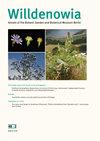Host specialization and molecular evidence support a distinct species of smut fungus, Anthracoidea hallerianae (Anthracoideaceae), on Carex halleriana (Cyperaceae)
IF 1.8
3区 生物学
Q2 PLANT SCIENCES
引用次数: 4
Abstract
Abstract: The species of Anthracoidea on Carex are host-specific smut fungi restricted to sedges belonging to the same or closely related sections. They are characterized by sori that form black, hard bodies around aborted nuts of their hosts. In Carex sect. Hallerianae, only one species, C. halleriana, is known as a host of Anthracoidea. The taxonomic status of this smut fungus was problematic due to a lack of molecular data. It has been reported under different names, mainly as “A. caricis” or “A. irregularis”. A comparative morphological study and molecular phylogenetic analysis, using LSU (large subunit) nuclear rDNA sequences, supported the recognition of a distinct species, A. hallerianae. The new species is described and illustrated based on material from Central Europe, the Iberian Peninsula, the Balkan Peninsula, the Mediterranean area and Transcaucasia. Citation: Denchev T. T., Denchev C. M., Koopman J., Begerow D. & Kemler M. 2021: Host specialization and molecular evidence support a distinct species of smut fungus, Anthracoidea hallerianae (Anthracoideaceae), on Carex halleriana (Cyperaceae). – Willdenowia 51: 57–67. Version of record first published online on 9 March 2021 ahead of inclusion in April 2021 issue.寄主特化和分子证据支持黑穗病真菌的一个独特物种,即黑穗炭疽菌科(炭疽菌科)和莎草科苔草属(莎草科)
摘要/ Abstract摘要:苔草炭疽科是一种寄主特有的黑穗病真菌,主要分布于苔草属的同一或相近科。它们的特点是梭菌在宿主流产的坚果周围形成黑色坚硬的体。在苔属昆虫中,只有一种是已知的炭疽纲寄主。由于缺乏分子数据,该菌的分类地位存在问题。它以不同的名称报道,主要是“A。A。irregularis”。利用LSU(大亚单位)核rDNA序列进行比较形态学研究和分子系统发育分析,支持了A. hallerianae这一独特物种的识别。根据中欧、伊比利亚半岛、巴尔干半岛、地中海地区和外高加索的资料,对新物种进行了描述和说明。引用本文:Denchev T. T., Denchev C. M., Koopman J., Begerow D.和Kemler M. 2021:寄主特化和分子证据支持一种独特的黑线菌,炭疽科(Anthracoidea hallerianae),在Carex halleriana (Cyperaceae)上。——《野生动物》51:57-67。记录版本于2021年3月9日首次在线发布,并于2021年4月被收录。
本文章由计算机程序翻译,如有差异,请以英文原文为准。
求助全文
约1分钟内获得全文
求助全文
来源期刊

Willdenowia
PLANT SCIENCES-
CiteScore
4.60
自引率
5.30%
发文量
17
审稿时长
>12 weeks
期刊介绍:
Willdenowia is an international peer-reviewed journal publishing original research articles in English from the entire fields of plant, algal and fungal systematics, covering the evolution, taxonomy and nomenclature of these organisms as well as related fields such as floristics and plant geography. Articles on phylogeny and molecular systematics are especially welcome, as are review articles. Descriptions of new taxa may be considered, but only if supported by robust evidence. Narrowly regional studies of widespread taxa, routine typifications, checklists and new floristic records are generally not considered (excluding contributions to the Euro+Med-Checklist Notulae). Authors are encouraged to deposit duplicates of their material, especially nomenclatural types, in the Berlin herbarium (B).
 求助内容:
求助内容: 应助结果提醒方式:
应助结果提醒方式:


